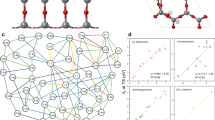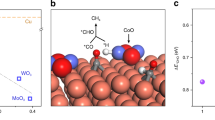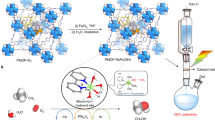Abstract
Using natural gas as chemical feedstock requires efficient oxidation of the constituent alkanes—and primarily methane1,2. The current industrial process uses steam reforming at high temperatures and pressures3,4 to generate a gas mixture that is then further converted into products such as methanol. Molecular Pt catalysts5,6,7 have also been used to convert methane to methanol8, but their selectivity is generally low owing to overoxidation—the initial oxidation products tend to be easier to oxidize than methane itself. Here we show that N-heterocyclic carbene-ligated FeII complexes with a hydrophobic cavity capture hydrophobic methane substrate from an aqueous solution and, after oxidation by the Fe centre, release a hydrophilic methanol product back into the solution. We find that increasing the size of the hydrophobic cavities enhances this effect, giving a turnover number of 5.0 × 102 and a methanol selectivity of 83% during a 3-h methane oxidation reaction. If the transport limitations arising from the processing of methane in an aqueous medium can be overcome, this catch-and-release strategy provides an efficient and selective approach to using naturally abundant alkane resources.
This is a preview of subscription content, access via your institution
Access options
Access Nature and 54 other Nature Portfolio journals
Get Nature+, our best-value online-access subscription
$29.99 / 30 days
cancel any time
Subscribe to this journal
Receive 51 print issues and online access
$199.00 per year
only $3.90 per issue
Buy this article
- Purchase on Springer Link
- Instant access to full article PDF
Prices may be subject to local taxes which are calculated during checkout



Similar content being viewed by others
Data availability
X-ray data are available free of charge from the Cambridge Crystallographic Data Centre under reference numbers CCDC-2106612 and 2106613. All other experimental, spectroscopic, crystallographic and computational data are available from the corresponding author upon request. Source data are provided with this paper.
References
Schwach, P., Pan, X. & Bao, X. Direct conversion of methane to value-added chemicals over heterogeneous catalysts: challenges and prospects. Chem. Rev. 117, 8497–8520 (2017).
Ravi, M., Ranocchiari, M. & van Bokhoven, J. A. The direct catalytic oxidation of methane to methanol—a critical assessment. Angew. Chem. Int. Ed. 56, 16464–16483 (2017).
Riaz, A., Zahedi, G. & Klemeš, J. J. A review of cleaner production methods for the manufacture of methanol. J. Clean. Prod. 57, 19–37 (2013).
Wang, B., Albarracín-Suazo, S., Pagán-Torres, Y. & Nikolla, E. Advances in methane conversion processes. Catal. Today 285, 147–158 (2017).
Shilov, A. E. & Shul’pin, G. B. Activation of C–H bonds by metal complexes. Chem. Rev. 97, 2879–2932 (1997).
Periana, R. A. et al. Platinum catalysts for the high-yield oxidation of methane to a methanol derivative. Science 280, 560–564 (1998).
Mironov, O. A. et al. Using reduced catalysts for oxidation reactions: mechanistic studies of the “Periana-catalytica” system for CH4 Oxidation. J. Am. Chem. Soc. 135, 14644–14658 (2013).
Gunsalus, N. J. et al. Homogeneous functionalization of methane. Chem. Rev. 117, 8521–8573 (2017).
Horn, R. & Schlögl, R. Methane activation by heterogeneous catalysis. Catal. Lett. 145, 23–39 (2015).
Arakawa, H. et al. Catalysis research of relevance to carbon management: progress, challenges, and opportunities. Chem. Rev. 101, 953–996 (2001).
Rosenzweig, A. C., Frederick, C. A., Lippard, S. J. & Nordlund, P. Crystal structure of a bacterial non-haem iron hydroxylase that catalyses the biological oxidation of methane. Nature 366, 537–543 (1993).
Whittington, D. A., Rosenzweig, A. C., Frederick, C. A. & Lippard, S. J. Xenon and halogenated alkanes track putative substrate binding cavities in the soluble methane monooxygenase hydroxylase. Biochemistry 40, 3476–3482 (2001).
Banerjee, R. & Lipscomb, J. D. Small-molecule tunnels in metalloenzymes viewed as extensions of the active site. Acc. Chem. Res. 54, 2185–2195 (2021).
Zimmermann, T., Soorholtz, M., Bilke, M. & Schüth, F. Selective methane oxidation catalyzed by platinum salts in oleum at turnover frequencies of large-scale industrial processes. J. Am. Chem. Soc. 138, 12395–12400 (2016).
Díaz-Urrutia, C. & Ott, T. Activation of methane: a selective industrial route to methanesulfonic acid. Science 363, 1326–1329 (2019).
Luo, Y.-R. Handbook of Bond Dissociation Energies in Organic Compounds 1st edn (CRC, 2002).
Agarwal, N. et al. Aqueous Au-Pd colloids catalyze selective CH4 oxidation to CH3OH with O2 under mild conditions. Science 358, 223–227 (2017).
Jin, Z. et al. Hydrophobic zeolite modification for in situ peroxide formation in methane oxidation to methanol. Science 367, 193–197 (2020).
Snyder, B. E. R. et al. The active site of low-temperature methane hydroxylation in iron-containing zeolite. Nature 536, 317–321 (2016).
Shan, J. et al. Mild oxidation of methane to methanol or acetic acid on supported isolated rhodium catalysts. Nature 551, 605–608 (2017).
Sushkevich, V. L., Palagin, D., Ranocchiari, M. & van Bokhoven, J. A. Selective anaerobic oxidation of methane enables direct synthesis of methanol. Science 356, 523–527 (2017).
Chen, Y.-H., Wu, C.-Q., Sung, P.-H., Chan, S. I. & Chen, P. P.-Y. Turnover of a methane oxidation tricopper cluster catalyst: implications for the mechanism of the particulate methane monooxygenase (pMMO). ChemCatChem 12, 3088–3096 (2020).
Sorokin, A. B., Kudrik, E. V. & Bouchu, D. Bio-inspired oxidation of methane in watercatalysed by N-bridged diiron phthalocyanine complex. Chem. Commun. 2008, 2562–2564 (2008).
İşci, Ü. et al. Site-selective formation of an iron(IV)–oxo species at the more electron-rich iron atom of heteroleptic μ-nitride diiron phthalocyanines. Chem. Sci. 6, 5063–5075 (2015).
Afanasiev, P. & Sorokin, A. B. μ-Nitrido diiron macrocyclic platform: particular structure for particular catalysis. Acc. Chem. Res. 49, 583–593 (2016).
Friedle, S., Reisner, E. & Lippard, S. J. Current challenges of modelling diiron enzyme active sites for dioxygen activation by biomimetic synthetic complexes. Chem. Soc. Rev. 39, 2768–2779 (2010).
Fujisaki, H. et al. Selective catalytic 2e−-oxidation of organic substrates by an FeII complex having an N-heterocyclic carbene ligand in water. Chem. Commun. 56, 9783–9786 (2020).
Garal, L., Dutasta, J.-P. & Collet, A. Complexation of methane and chlorofluorocarbons by cryptophane-A in organic solution. Angew. Chem. Int. Ed. 32, 1169–1171 (1993).
Kano, K., Kitae, T., Shimofuri, Y., Tanaka, N. & Mineta, Y. Complexation of polyvalent cyclodextrin ions with oppositely charged guests: entropically favourable complexation due to dehydration. Chem. Eur. J. 6, 2705–2713 (2000).
Branda, N., Wyler, R. & Rebek, J. Jr Encapsulation of methane and other small molecules in a self-assembling superstructure. Science 263, 1267–1268 (1994).
Brazeau, B. J., Wallar, B. J. & Lipscomb, J. D. Unmasking of deuterium kinetic isotope effects on the methane monooxygenase compound Q reaction by site-directed mutagenesis of component B. J. Am. Chem. Soc. 123, 10421–10422 (2001).
Li, J.-L., Zhang, X. & Huang, X.-R. Mechanism of benzene hydroxylation by high-valent bare FeIV=O2+: explicit electronic structure analysis. Phys. Chem. Chem. Phys. 14, 246–256 (2012).
Shimoyama, Y. & Kojima, T. Metal–oxyl species and their possible roles in chemical oxidations. Inorg. Chem. 58, 9517–9542 (2019).
Nash, T. The colorimetric estimation of formaldehyde by means of the Hantzsch reaction. Biochem. J. 55, 416–421 (1953).
Ruan, Y., Peterson, P. W., Hadad, C. M. & Badjić, J. D. On the encapsulation of hydrocarbon components of natural gas within molecular baskets in water. The role of C–H···π interactions and the host’s conformational dynamics in the process of encapsulation. Chem. Commun. 50, 9086–9089 (2014).
Duan, Z. & Mao, S. A thermodynamic model for calculating methane solubility, density and gas phase composition of methane-bearing aqueous fluids from 273 to 523 K and from 1 to 2000 bar. Geochim. Cosmochim. Acta 70, 3369–3386 (2006).
Rohde, J.-U. et al. Crystallographic and spectroscopic characterization of a nonheme Fe(IV)–O complex. Science 299, 1037–1039 (2003).
Sastri, C. V. et al. Axial ligand substituted nonheme FeIV=O complexes: observation of near-UV LMCT bands and Fe=O Raman vibrations. J. Am. Chem. Soc. 127, 12494–12495 (2005).
Andris, E. et al. Trapping iron(III)–oxo species at the boundary of the “oxo wall”: insights into the nature of the Fe(III)–O bond. J. Am. Chem. Soc. 140, 14391–14400 (2018).
Evans, D. F. & Jakubovic, D. Water-soluble hexadentate Schiff-base ligands assequestrating agents for iron(III) and gallium(III). J. Chem. Soc. Dalton Trans. 1988, 2927–2933 (1988).
Frisch, M. J. et al. Gaussian 16 revision C.01 (Gaussian, 2009).
Becke, A. D. Density-functional thermochemistry. III. The role of exact exchange. J. Chem. Phys. 98, 5648–5652 (1993).
Lee, C., Yang, W. & Parr, R. G. Development of the Colle–Salvetti correlation–energy formula into a functional of the electron density. Phys. Rev. B 37, 785–789 (1988).
Wachters, A. J. H. Gaussian basis set for molecular wavefunctions containing third-row atoms. J. Chem. Phys. 52, 1033–1036 (1970).
Hay, P. J. Gaussian basis sets for molecular calculations. The representation of 3d orbitals in transition-metal atoms. J. Chem. Phys. 66, 4377–4384 (1977).
Dunning, T. H. Jr & Hay, P. J. in Modern Theoretical Chemistry Vol. 3 (ed. Schaefer, H. F. III), (Plenum, 1977).
Cossi, M., Barone, V., Cammi, R. & Tomasi, J. Ab initio study of solvated molecules: a new implementation of the polarizable continuum model. Chem. Phys. Lett. 255, 327–335 (1996).
Grimme, S., Antony, J., Ehrlich, S. & Krieg, H. A consistent and accurate ab initio parameterization of density functional dispersion correction (DFT-D) for the 94 elements H-Pu. J. Chem. Phys. 132, 154104 (2010).
Frost, A. A. & Pearson, R. G. Kinetics and Mechanism (Wiley, 1961).
Acknowledgements
This work was supported by JST CREST (grant nos. JPMJCR16P1 and JPMJCR15P5) and by Grants-in-Aid (grant nos. 17H03027, 18K19089 and 21H01947) from the Japan Society for the Promotion of Science (JSPS). K.Y. and Y.S. acknowledge the MEXT projects of Cooperative Research Program of Network Joint Research Centre for Materials and Devices, Integrated Research Consortium on Chemical Sciences and the Elements Strategy Initiative to Form Core Research Centre. H.F. also acknowledges funding from JST SPRING (grant no. JPMJSP2124) and Research Fellowship for Young Scientists provided by JSPS (grant no. 22J10804). We thank Edanz (https://jp.edanz.com/ac) for editing a draft of this manuscript.
Author information
Authors and Affiliations
Contributions
T.K. conceived and directed the project. H.F. performed the experimental work and analysed the data. T.I. performed X-ray crystallographic analyses of the complexes. K.Y. and Y.S. performed the computational studies. H.K. contributed to kinetic studies. All of the authors discussed the results and H.F., T.I., Y.S. and T.K. prepared the manuscript.
Corresponding author
Ethics declarations
Competing interests
The authors declare no competing interests.
Peer review
Peer review information
Nature thanks Christian Limberg and Marco Ranocchiari for their contribution to the peer review of this work. Peer reviewer reports are available.
Additional information
Publisher’s note Springer Nature remains neutral with regard to jurisdictional claims in published maps and institutional affiliations.
Extended data figures and tables
Extended Data Fig. 1 Kinetic studies for the CH4 oxidation.
a, A GC-MS total-ion chromatogram for the reaction mixture of the CH4 (0.75 MPa) oxidation by 3-OH2, obtained by gas chromatography equipped with electron-ionization (EI) mass detector (GC-MS). b, EI-MS spectrum of the fraction eluted at the retention time of 3.09 min in a. c, Dependence of the initial rates, v0, for the catalytic oxidation of CH4 using 3-OH2, on the initial CH4 concentration, [CH4]. [CH4] were calculated on the basis of the values reported for aqueous solutions (0.25 MPa: 2.5 mM, 0.50 MPa: 5.0 mM, 0.75 MPa: 7.5 mM, and 0.98 MPa: 9.8 mM)36. The slope of the line, in which the v0 value at 0.98 MPa (9.8 mM) was omitted, since the initial rate showed saturation behaviour against the [CH4], is calculated to obtain the rate constant, kAntH, as (2.8 ± 0.1) × 10–6 s–1. d, A GC-MS total-ion chromatogram for the reaction mixture of CD4 (0.75 MPa) oxidation by 3-OH2. e, EI-MS spectrum of the fraction eluted at the retention time of 3.00 min in d. f, Dependence of the initial rates, v0, for the catalytic oxidation of CD4 using 3-OH2, on the initial CD4 concentration, [CD4]. The slope of the line is calculated to obtain the rate constant, kAntD, as (7.6 ± 0.8) × 10–8 s–1. Reaction conditions: [3-OH2] = 0.010 mM, [Na2S2O8] = 50 mM, solvent = H2O/CH3CN (95:5, v/v; pD was not adjusted), T = 323 K, reaction time: 3 h.
Extended Data Fig. 2 Entrapment of CH4 with 3-OD2 monitored by 1H NMR spectroscopy.
a, 1H NMR spectra of CH4, whose concentration was estimated to be 0.05 mM, in D2O/CD3CN (1:1, v/v) in the absence (top) and presence (bottom) of 3-OD2 (0.1 mM) at 298 K. b, 1H NMR spectra in D2O/CD3CN (1:1, v/v) of 3-OD2 (0.1 mM) at 298 K before (top) and after (bottom) bubbling CH4, whose concentration was estimated to be 0.05 mM.
Extended Data Fig. 3 Analysis of the chemical shift change for the 1H NMR signal of CH4 upon addition of the FeII-NHC complexes.
Plots of the chemical shift change for the 1H NMR signal of CH4 against the concentration of 3-OD2 at 298 K (a), 278 K (b), 308 K (c), and 323 K (d) in D2O/CD3CN (1:1, v/v). e, van’t Hoff plot for the association of CH4 with 3-OD2. Plots of the chemical shift change for the 1H NMR signal of CH4 against the concentration of 1-OD2 (f) and 2-OD2 (g) at 298 K. The fitting curves (solid lines) in a – d, f & g are calculated using equation (1) in the Methods as described previously29. The error bars in the plots represent the digital resolution for the 1H NMR spectroscopy under the conditions.
Extended Data Fig. 4 Spectroscopic data for 3-O.
CSI-TOF-MS spectra of 3-16O (top) and 3-18O (bottom), obtained from oxidation of 3-OH2 with 5 equiv of CAN in a mixed solvent of CH3CN:H216O (3:1) and CH3CN:H218O (3:1), diluted with CH3CN and measured at 278 K and their simulations (a) and the full-range spectra (m/z = 200 – 2000) (b). c, Microscopic Raman spectra of 3-O, formed from 3-OH2 with 5 equiv of CAN in CH3CN:H216O (3:1, v/v) (red) or CH3CN:H218O (3:1, v/v) (blue), at 298 K and the differential spectrum (black). d, UV-vis spectra of 3-OH2 (red); [FeIII(AntPY4Cl2BIm)(OH2)]2+ (blue), generated in-situ from 3-OH2 by addition of 1.2 equiv of CAN; 3-O (green), generated in-situ from 3-OH2 by addition of 5 equiv of CAN, in CH3CN:H2O (3:1). e, (top) ESR spectrum of the reaction mixture, quickly frozen during the catalytic oxidation of CH4 (3.5 mM) by 3-OH2 (0.1 mM) in the presence of Na2S2O8 (50 mM) in H2O:CH3CN (95:5) at 323 K; (bottom) ESR spectra of 3-OH2 (red), [FeIII(AntPY4Cl2-BIm)(OH2)]2+ (blue) and 3-O (green), obtained from oxidation of 3-OH2 with 1.2 equiv and 5 equiv of CAN, respectively, in CH3CN:H2O (3:1) (bottom).
Extended Data Fig. 5 DFT-calculated energy profile for the rate-determining HAT step in the CH4 oxygenation process.
Relative free energy values are given in kcal mol–1 with respect to a reactant complex consisting of the FeIV-oxo complex (3-O) and one trapped methane molecule. Here, “TS” and “Int” refer to a transition state generated during methane oxygenation and an intermediate consisting of the FeIII-OH complex and the methyl radical, respectively.
Supplementary information
Supplementary Information
This Supplementary Information PDF contains the following sections: general, synthesis and X-ray crystallography; also included are Supplementary Figs. 1–41, Supplementary Tables 1–4 and Supplementary References.
Source data
Rights and permissions
Springer Nature or its licensor (e.g. a society or other partner) holds exclusive rights to this article under a publishing agreement with the author(s) or other rightsholder(s); author self-archiving of the accepted manuscript version of this article is solely governed by the terms of such publishing agreement and applicable law.
About this article
Cite this article
Fujisaki, H., Ishizuka, T., Kotani, H. et al. Selective methane oxidation by molecular iron catalysts in aqueous medium. Nature 616, 476–481 (2023). https://doi.org/10.1038/s41586-023-05821-2
Received:
Accepted:
Published:
Issue Date:
DOI: https://doi.org/10.1038/s41586-023-05821-2
Comments
By submitting a comment you agree to abide by our Terms and Community Guidelines. If you find something abusive or that does not comply with our terms or guidelines please flag it as inappropriate.



